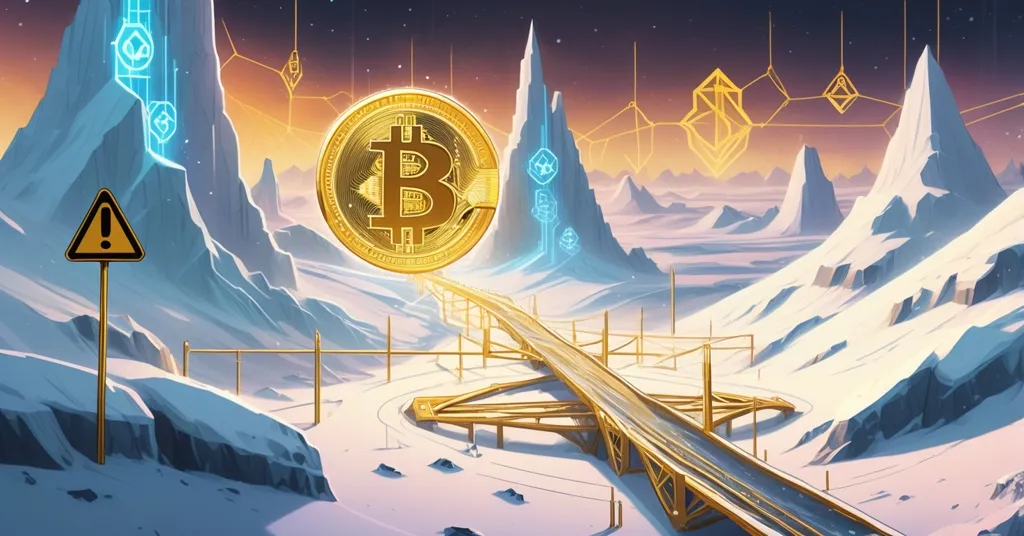Bitcoin Gains Flow to XRP Tundra: DeFi Yield Promise with High Stakes

Bitcoin Gains Fuel XRP Tundra: A DeFi Yield Bet with Big Potential and Bigger Risks
Bitcoin’s jaw-dropping surge past $126,000 in October had investors riding high—until a brutal 20% correction slapped them back to reality. Now, with profits locked in and volatility rearing its ugly head, many are hunting for safer harbors to park their gains. One name keeps popping up on analysts’ radars: XRP Tundra, a dual-chain DeFi ecosystem on Solana and XRP Ledger (XRPL), promising structured yields and long-term utility. But is this the next big play, or just another shiny object in crypto’s endless hype machine?
- Bitcoin peaks at $126,000, crashes 20%, prompting profit-taking.
- XRP Tundra gains traction with dual-chain DeFi and staking yields up to 20% APY.
- Presale hype meets skepticism—big potential, but unproven execution.
Bitcoin’s Wild Ride: Peak, Crash, and Capital Rotation
Bitcoin’s latest rally was a spectacle, smashing through $126,000 in October—likely 2024 based on current market cycles and project timelines. Fueled by massive inflows into spot ETFs and institutional buying, it seemed unstoppable. Then came the gut punch: a 20% drop, dragging BTC briefly below $100,000. Liquidations piled up, and whispers of shifting interest rate expectations spooked the market. Research outlets still project 2025 price targets between $120,000 and $200,000, but the days of 10x moonshots feel like ancient history in this maturing cycle. For many holders, it’s not about chasing the next pump—it’s about securing gains before the next inevitable dip.
This isn’t a new story. History shows that after every major Bitcoin rally, capital rotates out. Think back to the 2017 ICO craze or the 2021 DeFi summer—BTC profits often fuel the next wave of innovation (or speculation, depending on your cynicism). Today, with volatility on full display, decentralized finance (DeFi) is the natural next step for those seeking a mix of stability and yield. It’s not just about riding price waves anymore; it’s about building income streams while the market figures itself out. Enter XRP Tundra, a project positioning itself to catch this wave of Bitcoin profits with a promise of utility over empty hype, as highlighted in discussions about shifting Bitcoin profits into promising ecosystems like XRP Tundra.
What Is XRP Tundra? A Dual-Chain DeFi Experiment
For the uninitiated, let’s unpack XRP Tundra. It’s a DeFi ecosystem built on a dual-chain setup, operating across two blockchains with distinct strengths. Picture it as a highway with two lanes: Solana, known for lightning-fast, dirt-cheap transactions, handles the TUNDRA-S token focused on utility and yield. Meanwhile, the XRP Ledger (XRPL), often tied to financial use cases like cross-border payments, hosts TUNDRA-X for governance and reserve functions. This isn’t some random meme coin hoping for a viral tweet; XRP Tundra is pitching itself as a serious player with structured investment potential in a space still recovering from 2022’s trust-busting scams.
Currently in its presale Phase 11, the project has raised over $2.5 million, with more than $32,000 dished out in Arctic Spinner rewards to early backers. Channels like Token Empire on YouTube are spotlighting its role in XRPL’s budding DeFi scene, and analysts are taking notice. But let’s cut the fluff—presales are a gamble, always. While the setup looks intriguing, the road from pitch to reality is paved with broken dreams in crypto. So, what’s the actual deal here?
Presale Details: Big Numbers, Bigger Questions
XRP Tundra’s presale offers TUNDRA-S at $0.183 with a 9% bonus for buyers, while TUNDRA-X comes free with purchases at a reference value of $0.0915. Here’s the hook: confirmed listing prices are set at $2.50 for TUNDRA-S and $1.25 for TUNDRA-X, hinting at significant upside if things go as planned. The presale runs until January 12, 2026, or until tokens sell out—whichever hits first. Any leftovers? They’re burned permanently, a move to avoid dilution and pump scarcity. Sounds slick, right? But let’s not sip the Kool-Aid just yet. Listing prices are targets, not guarantees, and plenty of projects have flopped post-presale despite glossy promises.
Adding to the logistics, a dual airdrop of TUNDRA-S and TUNDRA-X will drop to presale participants one hour before trading kicks off on Meteora (for Solana’s TUNDRA-S) and Sologenic (for XRPL’s TUNDRA-X). Here’s the catch: only non-custodial wallets like Phantom for Solana or XUMM for XRPL are allowed. If you’re parked on Binance or Coinbase, you’re out of luck—custodial platforms don’t qualify, and screwing this up could mean losing your tokens. It’s a hassle, sure, but it’s also a middle finger to centralized control, putting power back in your hands. For newbies, non-custodial means you hold your own private keys—full ownership, but zero safety net if you mess up.
Staking Yields: The Big Draw That’s Not Yet Here
What’s really got analysts buzzing is XRP Tundra’s staking model, touted as a path to passive income for Bitcoin profit-takers. Dubbed Cryo Vaults, it’s not live yet, but the plan offers three tiers based on risk and commitment. Think of it like bank accounts with different interest rates: the Liquid tier (4-6% APY, no lock-up) is a no-strings deal for quick access; Balanced (8-12% APY, 30-day lock-up) offers a middle ground; and Premium (15-20% APY, 90-day lock-up) rewards the bold with higher yields for longer holds. Minimums range from 100 to 1,000 TUNDRA-S, keeping it accessible to smaller players while incentivizing bigger stacks.
There’s also a future tease of staking native XRP via Frost Keys, with yields again projected up to 20% APY once fully rolled out. For those new to staking, it’s like lending your crypto to support the network and earning interest in return—except risks like token devaluation or project failure always loom. Compared to established DeFi protocols like Lido or Aave, where yields often hover below 10%, XRP Tundra’s numbers look ambitious. Too ambitious? High APYs can signal unsustainable rewards or inflationary tokenomics. Without live data, it’s all speculation—and that’s a red flag worth waving.
Transparency and Trust: A Step Above, But No Guarantee
In a space still licking wounds from 2022’s rug pulls and collapses like FTX, XRP Tundra is at least trying to build trust. Smart-contract audits by Cyberscope, Solidproof, and FreshCoins check the code for nasty surprises, while the core team has passed KYC verification via Vital Block. This isn’t just for show—after scams galore, trust is the real currency in DeFi. But let’s be blunt: audits don’t mean success. They catch coding flaws, not execution failures. And KYC? It’s accountability, not a crystal ball. Will staking actually launch on time? Can the dual-chain model withstand real-world hacks or bridging risks, like the infamous Wormhole exploit? These are unanswered questions, and investing now is a leap of faith.
The Bigger Picture: Why DeFi, Why Now?
Zooming out, the allure of projects like XRP Tundra ties into a broader shift. Bitcoin’s post-rally volatility mirrors past cycles—big gains, sharp drops, then capital flows to altcoins or DeFi. With BTC’s upside looking less explosive for 2025, yield-bearing ecosystems are the new darling for investors wanting more than price speculation. Solana’s scalability and XRPL’s financial focus make a compelling combo, especially against Ethereum’s higher fees. Plus, DeFi on these chains challenges traditional finance head-on, offering financial freedom without middlemen—something Bitcoin maximalists might grumble about, but can’t replicate with pure store-of-value arguments.
Yet, here’s the counterpunch: many Bitcoin purists scoff at altcoin diversions. To them, BTC is the only true hedge against fiat decay—everything else is a distraction or scam waiting to implode. They’re not entirely wrong; over 60% of 2021-2022 DeFi projects failed to deliver post-presale, per historical trends tracked by platforms like CoinGecko. But XRP Tundra fills a niche Bitcoin doesn’t touch: yield generation and cross-chain utility. If you believe in diversification as a hedge against BTC’s swings, this kind of play might make sense. If you’re a maxi, you’ll likely call it nonsense and stack more sats.
Regulatory Shadows and Real-World Risks
Let’s not ignore the elephant in the room: regulation. XRPL’s ties to Ripple, still embroiled in SEC battles, cast a shadow over any DeFi project linked to it. Could XRP Tundra face scrutiny down the line? Possibly. Solana’s own history of network outages and centralized criticisms doesn’t help either. Then there’s the inherent risk of presales—countless projects have promised the moon only to crater on delivery. Staking isn’t active, so yields are a pipe dream for now. And those strict wallet rules? One wrong move, and your airdrop tokens are gone. This isn’t a game for the reckless.
Key Takeaways and Questions to Chew On
- Why are Bitcoin investors eyeing DeFi projects like XRP Tundra?
After BTC’s $126,000 peak and 20% crash, holders are cashing in gains and chasing stable yields in DeFi, especially as Bitcoin’s wild growth slows in this market cycle. - What makes XRP Tundra stand out in the crowded DeFi space?
Its dual-chain design on Solana and XRPL, presale structure with potential high returns at listing, promised staking yields of 4-20% APY, and audited contracts give it a credible pitch. - How does XRP Tundra’s presale and staking model operate?
Presale prices TUNDRA-S at $0.183 with bonuses and TUNDRA-X free, targeting listings at $2.50 and $1.25; staking via Cryo Vaults offers tiered yields up to 20% APY with varying lock-ups, though it’s not yet live. - What are the major risks of jumping into XRP Tundra now?
Staking remains unproven without active yields, non-custodial wallet rules risk token loss if ignored, presale uncertainty lingers until launch, and regulatory shadows over XRPL could bite later. - Why is DeFi gaining traction in this crypto market cycle?
As Bitcoin’s rallies slow, a maturing market drives capital to DeFi for passive income over pure price bets, with trust factors like audits becoming critical after past industry disasters.
XRP Tundra’s pitch is polished—dual-chain innovation, juicy yields, and a nod to decentralization that aligns with crypto’s core ethos of freedom and disruption. I’m cautiously optimistic; it fits where the space is heading, focusing on utility over empty pumps. But let’s not pretend this is a sure thing. Crypto’s graveyard is packed with slick ideas that never delivered. For Bitcoin holders flush with gains, rotating some into a project like this might be worth a shot—but only with eyes wide open. Dig deep, question everything, and never wager what you can’t lose. The game rewards the bold, but it buries the naive even quicker.



